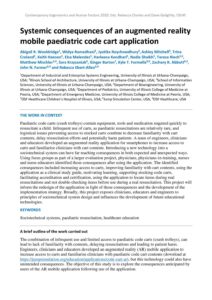| Document | Author Abigail R. Wooldridge, Widya Ramadhani, Jyotika Roychowdhury, Ashley Mitchell, Trina Croland, Keith Hanson, Elsa Melendez, Harleena Kendhari, Nadia Shaikh, Teresa Riech, Matthew Mischler, Sara Krzyzaniak, Ginger Barton, Kyle T. Formella, Zachary R. Abbott, John N. Farmer and Rebecca Ebert-Allen |
| Abstract Paediatric code carts (crash trolleys) contain equipment, tools and medication required quickly to resuscitate a child. Infrequent use of carts, as paediatric resuscitations are relatively rare, and logistical issues preventing access to stocked carts combine to decrease familiarity with cart contents, delay resuscitation efforts and potentially harm patients. A team of engineers, clinicians and educators developed an augmented reality application for smartphones to increase access to carts and familiarise clinicians with cart contents. Introducing a new technology into a sociotechnical system can have far reaching consequences in both expected and unexpected ways. Using focus groups as part of a larger evaluation project, physicians, physicians-in-training, nurses and nurse educators identified those consequences after using the application. The identified consequences included increasing access to carts, improving familiarity with cart contents, using the application as a clinical study guide, motivating learning, supporting stocking code carts, facilitating accreditation and certification, using the application to locate items during real resuscitations and not double-checking items before use during a real resuscitation. This project will inform the redesign of the application in light of those consequences and the development of the implementation strategy. Broadly, this project exposes clinicians, educators and engineers to principles of sociotechnical system design and influences the development of future educational technologies. |

